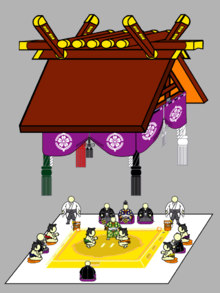- Dohyō
-
The dohyō (土俵) is the ring in which sumo wrestling bouts are held. A modern dohyo is a circle of rice-straw bales 4.55 meters in diameter, mounted on a square platform of clay 6.7m on a side, and 34 to 60 cm high. The surface is covered by sand.
A new dohyō is built prior to each tournament by the yobidashi, who are responsible for this activity. The dohyō is removed after each tournament, and in the case of Nagoya, pieces are taken home by the fans as souvenirs. The yobidashi also build the dohyō for training stables and sumo touring events.
The diameter of the ring is 15 shaku (4.55 meters), which increased from 13 shaku (3.94 meters) in 1931.[1] The rice-straw bales (tawara (俵)) which form the ring are one third standard size and are partially buried in the clay of the dohyō. Four of the tawara are placed slightly outside the line of the circle. In olden times this was to allow rain to run off the surface, when sumo tournaments were held outdoors in the open. Today a wrestler under pressure at the edge of the ring will often try to move himself round to one of these points to gain leverage in order to push back more effectively against the opponent who is trying to force him out.
At the center are two white lines, the shikiri-sen (仕切り線), behind which the wrestlers must position themselves at the start of the bout. Around the ring is finely brushed sand called the ja-no-me (蛇の目 snake's eye), which can be used to determine if a wrestler has just touched his foot, or another part of his body, outside the ring. The yobidashi ensure it is clean of any previous marks immediately prior to each bout.[2]
A roof resembling that of a Shinto shrine is suspended above the dohyō. Colored tassels (fusa) are suspended from the corners, representing the four spirits of directions:
- Azure Dragon of the East (青龍)
- Vermilion Bird of the South (朱雀)
- White Tiger of the West (白虎)
- Black Tortoise of the North (玄武)
References
- ^ Sumo and the Dohyo (Sumo ring) Nobuhiko Tsunefuka, 'The dohyo of the Edo period had a diameter of 13 shaku (3 m, 94 cm) and this size was enlarged by 61 centimeters at an Emperor’s Sumo match on April 29, 1931 to the current diameter of 15 shaku (4 m, 55 cm)'
- ^ Hall, Mina. (1997). The Big Book of Sumo. Stone Bridge Press. ISBN 1-880656-28-0.
Categories:- Sumo wrestling
- Sports venues
Wikimedia Foundation. 2010.



